[English] 日本語
 Yorodumi
Yorodumi- PDB-7l2c: Crystallographic structure of neutralizing antibody 2-51 in compl... -
+ Open data
Open data
- Basic information
Basic information
| Entry | Database: PDB / ID: 7l2c | ||||||
|---|---|---|---|---|---|---|---|
| Title | Crystallographic structure of neutralizing antibody 2-51 in complex with SARS-CoV-2 spike N-terminal domain (NTD) | ||||||
 Components Components |
| ||||||
 Keywords Keywords |  IMMUNE SYSTEM/Viral Protein / IMMUNE SYSTEM/Viral Protein /  COVID-19 / COVID-19 /  SARS-CoV-2 / SARS-CoV-2 /  Viral protein / Viral protein /  Spike glycoprotein / Spike glycoprotein /  N-terminal domain / NTD / N-terminal domain / NTD /  Neutralizing antibody / 2-51 / Neutralizing antibody / 2-51 /  Fab / Fab /  IMMUNE SYSTEM / IMMUNE SYSTEM /  IMMUNE SYSTEM-Viral Protein complex IMMUNE SYSTEM-Viral Protein complex | ||||||
| Function / homology |  Function and homology information Function and homology informationMaturation of spike protein / viral translation / Translation of Structural Proteins / Virion Assembly and Release / host cell surface / host extracellular space / suppression by virus of host tetherin activity / Induction of Cell-Cell Fusion / structural constituent of virion / host cell endoplasmic reticulum-Golgi intermediate compartment membrane ...Maturation of spike protein / viral translation / Translation of Structural Proteins / Virion Assembly and Release / host cell surface / host extracellular space / suppression by virus of host tetherin activity / Induction of Cell-Cell Fusion / structural constituent of virion / host cell endoplasmic reticulum-Golgi intermediate compartment membrane / entry receptor-mediated virion attachment to host cell / receptor-mediated endocytosis of virus by host cell / Attachment and Entry /  membrane fusion / positive regulation of viral entry into host cell / receptor-mediated virion attachment to host cell / membrane fusion / positive regulation of viral entry into host cell / receptor-mediated virion attachment to host cell /  receptor ligand activity / host cell surface receptor binding / fusion of virus membrane with host plasma membrane / fusion of virus membrane with host endosome membrane / receptor ligand activity / host cell surface receptor binding / fusion of virus membrane with host plasma membrane / fusion of virus membrane with host endosome membrane /  viral envelope / virion attachment to host cell / SARS-CoV-2 activates/modulates innate and adaptive immune responses / host cell plasma membrane / virion membrane / viral envelope / virion attachment to host cell / SARS-CoV-2 activates/modulates innate and adaptive immune responses / host cell plasma membrane / virion membrane /  membrane / identical protein binding / membrane / identical protein binding /  plasma membrane plasma membraneSimilarity search - Function | ||||||
| Biological species |   Severe acute respiratory syndrome coronavirus 2 Severe acute respiratory syndrome coronavirus 2  Homo sapiens (human) Homo sapiens (human) | ||||||
| Method |  X-RAY DIFFRACTION / X-RAY DIFFRACTION /  SYNCHROTRON / SYNCHROTRON /  MOLECULAR REPLACEMENT / Resolution: 3.65 Å MOLECULAR REPLACEMENT / Resolution: 3.65 Å | ||||||
 Authors Authors | Cerutti, G. / Reddem, E.R. / Shapiro, L. | ||||||
| Funding support |  China, 1items China, 1items
| ||||||
 Citation Citation |  Journal: Cell Host Microbe / Year: 2021 Journal: Cell Host Microbe / Year: 2021Title: Potent SARS-CoV-2 neutralizing antibodies directed against spike N-terminal domain target a single supersite. Authors: Gabriele Cerutti / Yicheng Guo / Tongqing Zhou / Jason Gorman / Myungjin Lee / Micah Rapp / Eswar R Reddem / Jian Yu / Fabiana Bahna / Jude Bimela / Yaoxing Huang / Phinikoula S Katsamba / ...Authors: Gabriele Cerutti / Yicheng Guo / Tongqing Zhou / Jason Gorman / Myungjin Lee / Micah Rapp / Eswar R Reddem / Jian Yu / Fabiana Bahna / Jude Bimela / Yaoxing Huang / Phinikoula S Katsamba / Lihong Liu / Manoj S Nair / Reda Rawi / Adam S Olia / Pengfei Wang / Baoshan Zhang / Gwo-Yu Chuang / David D Ho / Zizhang Sheng / Peter D Kwong / Lawrence Shapiro /  Abstract: Numerous antibodies that neutralize SARS-CoV-2 have been identified, and these generally target either the receptor-binding domain (RBD) or the N-terminal domain (NTD) of the viral spike. While RBD- ...Numerous antibodies that neutralize SARS-CoV-2 have been identified, and these generally target either the receptor-binding domain (RBD) or the N-terminal domain (NTD) of the viral spike. While RBD-directed antibodies have been extensively studied, far less is known about NTD-directed antibodies. Here, we report cryo-EM and crystal structures for seven potent NTD-directed neutralizing antibodies in complex with spike or isolated NTD. These structures defined several antibody classes, with at least one observed in multiple convalescent donors. The structures revealed that all seven antibodies target a common surface, bordered by glycans N17, N74, N122, and N149. This site-formed primarily by a mobile β-hairpin and several flexible loops-was highly electropositive, located at the periphery of the spike, and the largest glycan-free surface of NTD facing away from the viral membrane. Thus, in contrast to neutralizing RBD-directed antibodies that recognize multiple non-overlapping epitopes, potent NTD-directed neutralizing antibodies appear to target a single supersite. | ||||||
| History |
|
- Structure visualization
Structure visualization
| Structure viewer | Molecule:  Molmil Molmil Jmol/JSmol Jmol/JSmol |
|---|
- Downloads & links
Downloads & links
- Download
Download
| PDBx/mmCIF format |  7l2c.cif.gz 7l2c.cif.gz | 300.4 KB | Display |  PDBx/mmCIF format PDBx/mmCIF format |
|---|---|---|---|---|
| PDB format |  pdb7l2c.ent.gz pdb7l2c.ent.gz | 238.4 KB | Display |  PDB format PDB format |
| PDBx/mmJSON format |  7l2c.json.gz 7l2c.json.gz | Tree view |  PDBx/mmJSON format PDBx/mmJSON format | |
| Others |  Other downloads Other downloads |
-Validation report
| Arichive directory |  https://data.pdbj.org/pub/pdb/validation_reports/l2/7l2c https://data.pdbj.org/pub/pdb/validation_reports/l2/7l2c ftp://data.pdbj.org/pub/pdb/validation_reports/l2/7l2c ftp://data.pdbj.org/pub/pdb/validation_reports/l2/7l2c | HTTPS FTP |
|---|
-Related structure data
| Related structure data |  7l2dC  7l2eC  7l2fC  7lqvC  7lqwC  7c2lS S: Starting model for refinement C: citing same article ( |
|---|---|
| Similar structure data |
- Links
Links
- Assembly
Assembly
| Deposited unit | 
| ||||||||
|---|---|---|---|---|---|---|---|---|---|
| 1 | 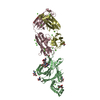
| ||||||||
| 2 | 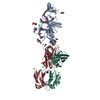
| ||||||||
| Unit cell |
|
- Components
Components
-Protein , 1 types, 2 molecules AB
| #1: Protein |  Spike protein / S glycoprotein / E2 / Peplomer protein Spike protein / S glycoprotein / E2 / Peplomer proteinMass: 38861.996 Da / Num. of mol.: 2 Source method: isolated from a genetically manipulated source Source: (gene. exp.)   Severe acute respiratory syndrome coronavirus 2 Severe acute respiratory syndrome coronavirus 2Gene: S, 2 / Production host:   Homo sapiens (human) / References: UniProt: P0DTC2 Homo sapiens (human) / References: UniProt: P0DTC2 |
|---|
-Antibody , 2 types, 4 molecules HCLD
| #2: Antibody | Mass: 24369.305 Da / Num. of mol.: 2 Source method: isolated from a genetically manipulated source Source: (gene. exp.)   Homo sapiens (human) / Production host: Homo sapiens (human) / Production host:   Homo sapiens (human) Homo sapiens (human)#3: Antibody | Mass: 22591.912 Da / Num. of mol.: 2 Source method: isolated from a genetically manipulated source Source: (gene. exp.)   Homo sapiens (human) / Production host: Homo sapiens (human) / Production host:   Homo sapiens (human) Homo sapiens (human) |
|---|
-Sugars , 2 types, 14 molecules 
| #4: Polysaccharide | 2-acetamido-2-deoxy-beta-D-glucopyranose-(1-4)-2-acetamido-2-deoxy-beta-D-glucopyranose / Mass: 424.401 Da / Num. of mol.: 1 / Mass: 424.401 Da / Num. of mol.: 1Source method: isolated from a genetically manipulated source |
|---|---|
| #5: Sugar | ChemComp-NAG /  N-Acetylglucosamine N-Acetylglucosamine |
-Non-polymers , 5 types, 91 molecules 

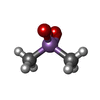
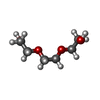





| #6: Chemical | ChemComp-CA / #7: Chemical | ChemComp-ACT /  Acetate Acetate#8: Chemical | ChemComp-CAC / |  Cacodylic acid Cacodylic acid#9: Chemical | ChemComp-PGE / |  Polyethylene glycol Polyethylene glycol#10: Water | ChemComp-HOH / |  Water Water |
|---|
-Details
| Has ligand of interest | Y |
|---|
-Experimental details
-Experiment
| Experiment | Method:  X-RAY DIFFRACTION / Number of used crystals: 1 X-RAY DIFFRACTION / Number of used crystals: 1 |
|---|
- Sample preparation
Sample preparation
| Crystal | Density Matthews: 3.05 Å3/Da / Density % sol: 63.38 % |
|---|---|
Crystal grow | Temperature: 298 K / Method: vapor diffusion, sitting drop / pH: 6.5 Details: 0.16 M Calcium Acetate, 0.08 M Sodium Cacodylate, 14.4% PEG 8000, 20% Glycerol |
-Data collection
| Diffraction | Mean temperature: 100 K / Serial crystal experiment: N |
|---|---|
| Diffraction source | Source:  SYNCHROTRON / Site: SYNCHROTRON / Site:  APS APS  / Beamline: 24-ID-C / Wavelength: 0.979 Å / Beamline: 24-ID-C / Wavelength: 0.979 Å |
| Detector | Type: DECTRIS EIGER X 16M / Detector: PIXEL / Date: Oct 14, 2020 |
| Radiation | Protocol: SINGLE WAVELENGTH / Monochromatic (M) / Laue (L): M / Scattering type: x-ray |
| Radiation wavelength | Wavelength : 0.979 Å / Relative weight: 1 : 0.979 Å / Relative weight: 1 |
| Reflection | Resolution: 3.44→88.03 Å / Num. obs: 25964 / % possible obs: 93.26 % / Redundancy: 1.9 % / CC1/2: 0.883 / Net I/σ(I): 2.57 |
| Reflection shell | Resolution: 3.44→3.65 Å / Num. unique obs: 5916 / CC1/2: 0.44 |
- Processing
Processing
| Software |
| |||||||||||||||||||||||||||||||||||||||||||||||||||||||||||||||
|---|---|---|---|---|---|---|---|---|---|---|---|---|---|---|---|---|---|---|---|---|---|---|---|---|---|---|---|---|---|---|---|---|---|---|---|---|---|---|---|---|---|---|---|---|---|---|---|---|---|---|---|---|---|---|---|---|---|---|---|---|---|---|---|---|
| Refinement | Method to determine structure : :  MOLECULAR REPLACEMENT MOLECULAR REPLACEMENTStarting model: 7C2L Resolution: 3.65→88.03 Å / SU ML: 0.46 / Cross valid method: FREE R-VALUE / σ(F): 1.35 / Phase error: 27.12 / Stereochemistry target values: ML
| |||||||||||||||||||||||||||||||||||||||||||||||||||||||||||||||
| Solvent computation | Shrinkage radii: 0.9 Å / VDW probe radii: 1.11 Å / Solvent model: FLAT BULK SOLVENT MODEL | |||||||||||||||||||||||||||||||||||||||||||||||||||||||||||||||
| Refinement step | Cycle: LAST / Resolution: 3.65→88.03 Å
| |||||||||||||||||||||||||||||||||||||||||||||||||||||||||||||||
| Refine LS restraints |
| |||||||||||||||||||||||||||||||||||||||||||||||||||||||||||||||
| LS refinement shell |
|
 Movie
Movie Controller
Controller









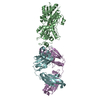


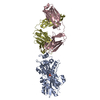




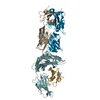
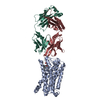
 PDBj
PDBj














